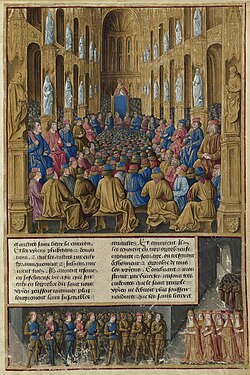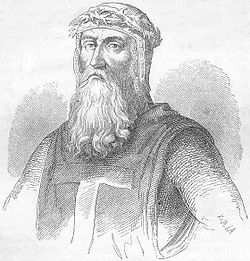
The First Crusade was a religious crusade undertaken by Christians of Western Europe to the Holy Land in the late 1090s. It was first preached by Pope Urban II at the Council of Clermont in the Auvergne region of France late in 1095. Thereafter a number of prominent Norman and other European lords took the cross and led tens of thousands of crusaders across Europe to Constantinople, then into Asia Minor and finally to the Levant in 1097. Two years of fighting followed before the Crusaders seized their ultimate goal, the city of Jerusalem. The capture of Jerusalem and the conquest of the Levant led to the creation of four Crusader states: the Kingdom of Jerusalem, the County of Tripoli, the Principality of Antioch and the County of Edessa. Tens of thousands of Christians settled here in the twelfth century, with lasting impacts for future centuries, even though the Crusader states were gradually conquered in the twelfth and thirteenth centuries.[1]
The First Crusade chronology of eventsThe First Crusade chronology of events

Back in late antiquity when Christianity began to emerge as a major religious force across the Roman world, the most vibrant heartland of Christianity was in the Eastern Mediterranean in places like Egypt, Greece, Asia Minor (modern-day Turkey) and the Levant. These remained major centers of Christian worship and culture down to the seventh century, but then the enormously rapid and expansive Arab conquests spread Islam with great speed across the Middle East, the Levant, North Africa and Asia Minor. Over a period of decades much of the population of these areas converted to Islam.[2]
This in itself did not create a complete impediment towards Christians from Europe visiting the Holy Land and Jerusalem on pilgrimages. What caused that latter issue was the arrival of the Seljuk Turks into Asia Minor and parts of the Middle East in the tenth and eleventh centuries. These newcomers not only blocked Christian pilgrims from heading to the Holy Land at times, particularly so after they captured Jerusalem in 1071, but posed a new threat to the Greek Orthodox Byzantine Empire and the security of the city of Constantinople. Fearful that the Turks would soon conquer his capital, the Byzantine emperor, Alexios I Komnenos, sent out ambassadors in the mid-1090s to his Christian brethren in Western Europe appealing for military aid. It would be the beginning of two centuries of Crusader warfare.[3]
The head of the Western Roman Catholic Church in the 1090s when Alexios’s emissaries arrived to Italy was Pope Urban II. Shortly afterwards, at the Council of Clermont in Auvergne in France, he preached a Christian crusade to the Holy Land. In the months that followed tens of thousands of Christian knights and soldiers, with auxiliary staff, began making their way to the Levant, led by Norman and Flemish lords such as Godfrey of Bouillon, his brother Baldwin and Bohemond of Taranto. These generally headed overland to Constantinople, some sailing via Italy, before consolidating their position and then crossing the Bosporus into Asia Minor. From this point onwards in the spring of 1097, they were in conflict with the Turks as they passed through Asia Minor to the Levant.[4]
The fighting would last for over two years. Nicaea in western Turkey, where the famous Council of Nicaea had done so much to formulate the structures of the early Christian church back in the fourth century, was seized in 1097. Edessa (modern-day Urfa in south-eastern Turkey) was conquered in the spring of 1098, following which a lengthy siege of Antioch was concluded successfully in June of that year. Finally, the Crusaders marched south along the shores of the Eastern Mediterranean, taking locations like Jaffa before commencing the siege of Jerusalem in early June 1099. Five weeks later the city fell to the Europeans, bringing the First Crusade to a successful conclusion.[5]
In the aftermath of the capture of Jerusalem the conquered lands, which became known to the Crusaders as Outremer meaning ‘Overseas’, were divided up into four Crusader states: the Kingdom of Jerusalem, the County of Tripoli, the Principality of Antioch and the County of Edessa. These would be ruled by a King of Jerusalem, the first of which was Godfrey of Bouillon, and a Prince of Antioch and Counts of Edessa and Tripoli. However, they would only hold sway for half a century. Beginning in the 1140s concerted efforts by the neighboring Muslim powers to reconquer the Crusader states commenced, necessitating new crusades over time. Jerusalem fell to Saladin and his armies in 1187. The gradual erosion of the Crusader presence in the Levant culminated in 1291 in the fall of the city of Acre, which was effectively the end of the Crusader states in the Holy Land.[6]
Extent of migration during and after First CrusadeExtent of migration during and after First Crusade
The First Crusade ushered in a period of extensive migration from Western Europe to the Levant. In the first instance, tens of thousands of Norman, Flemish, Frankish and German knights, soldiers and their followers arrived to the Holy Land in 1098 and 1099. Thereafter the Crusader states were quite powerful for several decades and many thousands of people moved over and back across the Mediterranean from regions like Italy to cities like Jaffa, Acre, Antioch and Jerusalem. There was much need of migration, as the Crusaders had mercilessly mass-murdered the Muslim population of cities like Jerusalem after seizing them during the Crusade. Many of those who arrived from the 1100s onwards were soldiers, others were administrators and church figures, while others still were merchants, the Italian city states like Venice, Pisa and Genoa having extensive trading concessions in the ports of Outremer.[7]
Demographic impact of the First CrusadeDemographic impact of the First Crusade
The demographic impact was very substantial in the twelfth and thirteenth centuries. As well as the first arrival of tens of thousands of people to the Holy Land at the very end of the eleventh century, a steady flow of arrivals occurred in the decades that followed. This was often augmented by new crusades. For instance, at the time of the Second Crusade at the end of the 1140s, preached owing to the Muslim capture of the city of Edessa in 1146, over 50,000 knights, soldiers and auxiliaries from Western and Central Europe arrived to the Holy Land under the command of King Louis VII of France, King Conrad III of Germany and many other Christian lords. This expanded the settlement of European Christians here.[8] The Third Crusade in the late twelfth century involved the conquest of Cyprus and led to Western European settlement here. More broadly, it could be contended that the Crusades provided a boon to the Christian community of the Lebanon which had survived in the mountains and foothills of the region through the Muslim conquests and which still form a major component of the Lebanese religious landscape down to the present day. Approximately one-third of the country’s 5.6 million people are still Christians, mostly of the Maronite Church.[9]
Explore more about the First CrusadeExplore more about the First Crusade
- First Crusade at World History Encyclopedia
- The Crusades and the Normans at University of Exeter
- “My Ancestors were Normans” – Oh really? Prove it! at Legacy Family Tree Webinars
References
- ↑ https://www.worldhistory.org/First_Crusade/
- ↑ https://www.thecollector.com/arab-conquests-history-legacy/
- ↑ https://www.history.com/this-day-in-history/pope-urban-ii-orders-first-crusade
- ↑ https://www.historic-uk.com/HistoryUK/HistoryofEngland/Timeline-Crusades/
- ↑ https://www.worldhistory.org/First_Crusade/
- ↑ Thomas Asbridge, The Crusades: The War for the Holy Land (London, 2012).
- ↑ https://books.openedition.org/pus/6020?lang=en
- ↑ https://www.history.com/topics/middle-ages/crusades
- ↑ https://newlinesmag.com/essays/maronite-christians-and-the-third-way/

